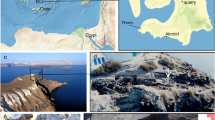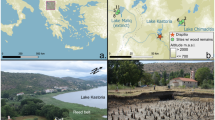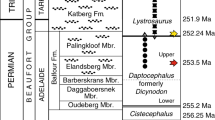Abstract
THE caldera walls of the ring-islands Thera and Therasia, belonging to the Santorini Group (Fig. 1) in the southern Aegean, are built up of lavas and pyroclastics, among which pumice layers are particularly striking (Fig. 2). The top layer (Bo, abbreviated from the German term “oberer Bimsstein”1) comprises air-fall pumice and ashes, overlain by thick pyroclastic flows2,3. It was produced by the catastrophic outburst of the Thera volcano in late-Minoan time, which culminated in the collapse of the Santorini caldera4. The decline of the Minoan civilisation around 1500 BC has been attributed to these volcanic events5. The Upper Pumice Series buried late-Minoan settlements on Thera and Therasia, and an important settlement near Akrotiri in the southern part of Thera is still being excavated6. The Upper Pumice Series rests on an old soil horizon (black layer in Fig. 2) in which remnants of late-Minoan houses were found in 1869 (ref. 7). Wood from such houses found at the base of the pumice quarries south of the town of Fira has provided radiocarbon dates of 3,370±100 yr b.p. (ref. 8). This age coincides exactly with archaeological data for the destruction of late-Minoan settlements on Santorini6.
This is a preview of subscription content, access via your institution
Access options
Subscribe to this journal
Receive 51 print issues and online access
$199.00 per year
only $3.90 per issue
Buy this article
- Purchase on Springer Link
- Instant access to full article PDF
Prices may be subject to local taxes which are calculated during checkout
Similar content being viewed by others
References
Reck, H., Der Werdegang eines Inselvulkans und sein Ausbruch 1925–28 (Reimer, Berlin 1936).
Pichler, H., Naturwissenschaften, 60, 198 (1973).
Günther, D., and Pichler, H., N. Jb. Geol Paläont. Mh., 394–415 (1973).
Pichler, H., Günther, D., and Kussmaul, S., Naturwissenschaften, 59, 188–197 (1972).
Marinatos, Sp., Antiquity, 13, 425–439 (1939).
Marinatos, Sp., Excavations at Thera I-V (Athens, 1972).
Fouqué, F., Rev. Deux Mondes, 39, 923–943 (1869).
Galanopoulos, A. G., Annls géol. hell., 9, 184–185 (1958).
Wijmstra, T. A., Acta Bot. Neerlandia, 18, 511–527 (1969).
Bond, A., Nature, 259, 194–195 (1976).
Ryan, W. B. F., in The Mediterranean Sea, 149–169 (Dowden, Hutchinson and Ross, Stroudsburg, 1972).
Mellis, O., Deep Sea Res., 2, 89–92 (1954).
Ninkovich, D., and Heezen, B. C., Colston Papers, 17, 413–452 (Butterworths, London, 1965).
Keller, J., and Ninkovich, D., Z. dt. geol. Ges., 123, 579–587 (1972).
Günther, D., thesis Univ. Tübingen (1972).
Rubin, M., and Suess, H. E., Science, 121, 481–488 (1955).
Author information
Authors and Affiliations
Rights and permissions
About this article
Cite this article
PICHLER, H., FRIEDRICH, W. Radiocarbon dates of Santorini volcanics. Nature 262, 373–374 (1976). https://doi.org/10.1038/262373a0
Received:
Accepted:
Published:
Issue Date:
DOI: https://doi.org/10.1038/262373a0
This article is cited by
-
Evolution of the crustal magma plumbing system during the build-up to the 22-ka caldera-forming eruption of Santorini (Greece)
Bulletin of Volcanology (2013)
-
Prehistoric mega-tsunami in the eastern Mediterranean and its sedimentary response
Rendiconti Lincei (2005)
-
Caldera formation on Santorini and the physiography of the islands in the late Bronze Age
Bulletin of Volcanology (1992)
-
Palaeomagnetic estimates of emplacement temperatures of pyroclastic deposits on Santorini, Greece
Bulletin of Volcanology (1989)
-
Soils on Santorini at ∼1500 BC
Nature (1978)
Comments
By submitting a comment you agree to abide by our Terms and Community Guidelines. If you find something abusive or that does not comply with our terms or guidelines please flag it as inappropriate.



